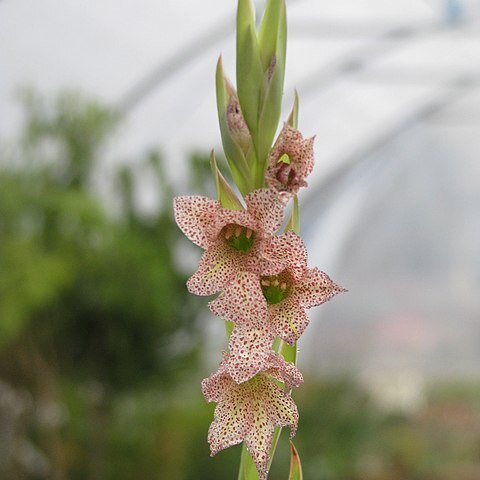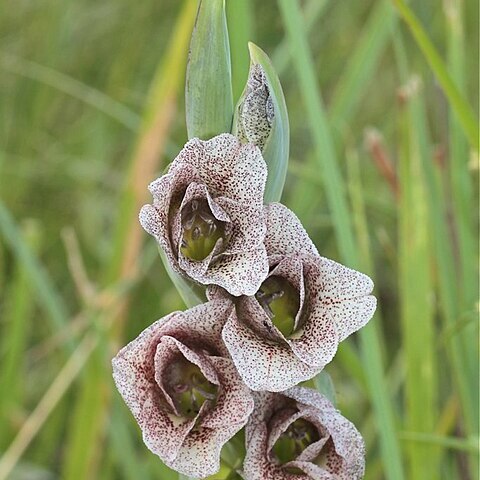Plants 150-350(-700) mm high, occasionally taller. Corm depressed-globose, 25-40 mm diam.; tunics brittle-papery to cartilaginous, decaying irregularly. Stem inclined in upper 2/3, unbranched. Leaves (6)7 to 9(13), lower 4 ± basal and usually forming a crowded fan reaching to ± middle of stem, rarely to base of spike, lanceolate, 15-30(-53) mm wide, margins moderately to strongly thickened, main vein barely thickened, upper 2 leaves entirely sheathing or with vestigial blades, bract-like and slightly inflated. Spike inclined, 8-to 12(-26)-flowered; bracts sometimes flushed with purple below, strongly keeled, keels usually reddish, outer 43-53 mm long, (2-)3 internodes long, inner bracts shorter or rarely ± as long, acute and entire, those of lower flowers folded or keeled, those of upper flowers 2-keeled. Flowers variously spotted or speckled pink, red or purple on a white background, sometimes so densely spotted as to appear uniformly pink at least on distal 1/2 of tepals, lower 3 tepals with yellow to cream-coloured spear-shaped nectar guides on lower 1/2, closing tightly at night, unscented; perianth tube obliquely funnel-shaped, (14-)17-20 mm long; tepals broadly ovate-elliptic, sometimes emarginate-apiculate, dorsal horizontal, hooded over stamens, (25-)28-35 x (13-)15-20 mm, upper laterals usually longer than dorsal, (24-)28-37 x (11-)16-21 mm, lower lateral tepals smallest, 18-20 x 9-15 mm, lower median (22-)28-35 x (9-)13-20 mm, arching outward and downward. Filaments 12-15 mm long, exserted 4-5 mm from tube but included in lower part of flower; anthers 7-10 mm long, cream-coloured; pollen white. Style arching over stamens, dividing opposite middle of anthers, branches ± 4 mm long. Capsules obovoid, weakly 3-lobed above and retuse, 18-25 mm long. Seeds discoid, broadly and usually evenly winged, 7-8 x 4.5-6.0 mm.
More
Perennial herb, geophyte, 0.25-1.00 m high; corm depressed-globose, tunics brittle-papery to cartilaginous; stem erect below, inclined above, simple. Leaves (6)7-9, lanceolate, 15-30(-53) mm wide, basal forming distichous fan, midribs and margins ± thickened. Bracts bright green, or flushed with purple below, keels reddish. Inflorescence an inclined spike; flowers 8-12(-26), spotted pink, red or purple; tepals unequal, ovate-elliptic, arching outward and downwards, 3 lower tepals with yellow to cream-coloured, broad to narrow nectar guides, apex emarginate-apiculate, dorsal horizontal, hooded over stamens. Stamens exserted; anthers cream-coloured; pollen white. Ovary oblong; style arching over stamens. Flowering time Dec.-Mar. Capsule obovoid, weakly 3-lobed above, apex retuse.
Cormous geophyte, up to 0.5 m high. Leaves sword-shaped (ensiform), fairly short. Flowers: in a 8-12-flowered spike; bracts boat-shaped, imbricate, somewhat inflated and folded on midline, 40-80 mm long; anthers 7-10 mm long, cream-coloured; perianth directed outward and forward (porrect) with a short tube, white, speckled with red or maroon, rarely pink; Nov.-Apr.
A herb. It has a corm with long bristles. There are about 5 leaves. They spread fan wise. They are 20-25 cm long by 1.5-2 cm wide. The flowering stalk is 50 cm high. The flowers overlap each other in a spike. They are white with purple speckles.


